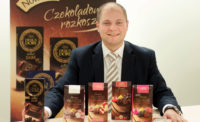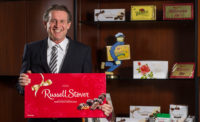How a Brazilian Confectionery Concept is Being Translated to the U.S. Market
By Renee Covino
Ricardo Marque didn’t set out to uncover Latin American cultural differences in selling sweet treats — he meant to build on a successful Brazilian concept now franchised in the United States — Showcolate Fondue Express. But in doing that, he also got an education in key consumer taste and merchandising preferences that unlocked some of the secrets to making a confection fly from one country to another.
Brazilian chocolate fondue concept, Showcolate,
combines the Brazilian snack favorites of fruit and chocolate and is touted
as “all the rage in South America” since 2003. Recently, it has
expanded into the United States as a kiosk franchise thanks to the
partnership of Gary Findley, former president of Curves International.
Seeing promise in the Brazilian-born concept, Findley took 10 Showcolate
franchises for himself, and recently employed his franchise consulting and
development company, the Findley Group, to extend the franchise offering
nationwide. Ricardo Marque was hired as president of U.S. Operations
— Showcolate USA.
“Little did we know there are so many
differences culturally that needed to be addressed,” says Marque.
“While fruit and chocolate is a confection that translates across
cultures, we noticed customer behaviors can be very different. We had to
adjust just about everything for the American reality.”
The basic concept is the same. Showcolate franchises
operate from state-of-the-art kiosks of about 100 square feet, which
feature its patented chocolate spinning wheels. The menu features 20
different selections from fruit skewers drizzled in milk, dark or white
chocolate to “cup” treats that feature up to three different
types of fruit covered in chocolate and nuts.
Consumers have been known to gather around to
leisurely smell and watch the cascading waterfalls of warm Ghirardelli
chocolate pouring down from multiple spinning wheels. At least that’s
how it is in Brazil.
Here, Marque says there is a slight difference.
“In the U.S., people definitely want to see what they’re buying
first, but they want it pretty fast, they’re on-the-go. If I had a
skewer that was ready in Brazil, most consumers would wait for a fresh one.
Here in the states, people take what’s on display.”
Because fresh fruit and fresh fruit with chocolate
resonates so well with Latin Americans, the Showcolate concept “has
definitely established a connection faster with Hispanics in the United
States,” maintains Marque. “Plus, we don’t have to
explain what fondue is; they know it’s fruit covered with chocolate.
We see ourselves explaining it more to non-Hispanic consumers.”
And so Showcolate USA came up with a flat screen
advertising concept, where inside the kiosks, the company shows a
continuous movie clip of consumers enjoying the dessert.
Showcolate USA also simplified its product names for
the American marketplace. “In Brazil, our ‘Sensation’ is
a fruit cup covered in chocolate; our ‘Passion’ is a fruit cup
covered in chocolate and nuts,” Marque explains. “Here, we just
call it ‘fondue cup’ with or without nuts. It’s important
to have a culturally different consumer instantly identify with a product.
You have to make that first connection.”
Currently, more than 100 Showcolate franchises operate
worldwide. The Findley Group plans to have 34 Showcolate franchises sold in
the United States by the end of the year.
The “Minors” Are Becoming More Major . . .
By the year 2045, the U.S.
population is expected to grow by 50 percent. Of that increase, nearly 90
percent is expected to come from the “minority” community of
African Americans, Hispanics, Asians and women.
“Retailers and manufacturers with food and snack
items will definitely have to tweak their taste profiles in order to be
relevant to these particular markets,” says Phil Wilkins, CEO of
Diverse Wealth Systems, a diversity consulting company based in Lexington,
Ky.
“There is evidence that not only does it make
good business sense, but particularly in the context of food and music
— those are two areas where cultural components are critical,”
adds Michele Valdovinos, vice president of research and marketing for
Phoenix Cultural Access Group, based in Los Angeles.
For retailers, here are a few tips to prepare for
reaching out to a more culturally diverse group:
Figure out who the
multi-cultural consumers are that are shopping your stores. “And know them by their country of origin, not
just the Hispanic market, for example,” says Sharmila Fowler,
managing director of strategy and consulting for the Phoenix Cultural
Access Group.
Hire a diverse work force that especially reflects your
demographics in culturally diverse neighborhoods. “That sends the strongest message to ethnic consumers
when they decide where to shop,” says Wilkins.
Get involved in a diverse community. “If you’re going to penetrate these markets, you
not only have to sell to them, you have to understand them,” he adds.
This includes community groups and events geared toward different cultures
and holidays.
Advertise to them in-store. “It’s
not a question of offending them if you don’t do it, but it’s a
matter of being pleasantly surprised if you make them feel welcomed and
directly addressed,” says Wilkins.
Start with a kiosk, and then place it in the mainstream
aisles, if appropriate. “You don’t
want to explode across the store,” says Valdovinos. For Mexican
candy, for example, she recommends using a small display with a
piñata to first attract attention. If it proves successful, more
SKUs could be incorporated into a regular candy set over time.
Tapping into the Sweet Asian Beat
Has your company looked at
the Asian population beyond the Census 2000? The American Community Survey
has — and just as importantly — Kang & Lee Advertising has
recently analyzed it to provide the industry with the latest stats on the
growing group. Here are some highlights.
Mid-decade, the total Asian population of the
United States has grown to 12.4 million, a 23 percent increase over the
Census 2000 benchmark.
While Chinese Americans comprise the
single-largest Asian group, the three fastest-growing Asian populations
are, in rank order, Asian Indians, Vietnamese and Filipinos.
Since 2000, the Asian Indian population grew 41
percent and now totals 2.32 million.
The Vietnamese population grew 28 percent and
now totals 1.42 million.
The Filipino population grew 22 percent and now
totals 2.28 million.
The South region of the country boasts the
fastest Asian population growth rate (31 percent), followed by the Midwest
(24 percent), the Northeast (23 percent), and the West (19 percent).
A total of 37 states experienced Asian
population growth rates in excess of 20 percent since 2000. The states with
the top five Asian population growth rates include: North Dakota (63
percent), Nevada (55 percent), New Hampshire (48 percent), Arizona (42
percent), and Florida (40 percent).
Of these, Nevada and Arizona each have Asian
populations that are in excess of 100,000.






